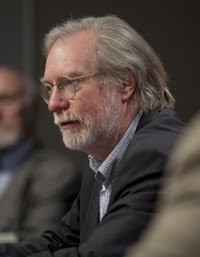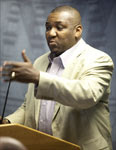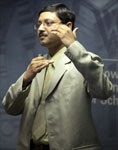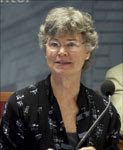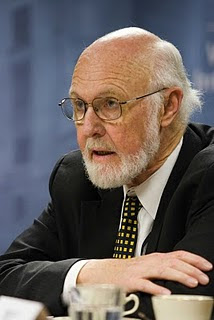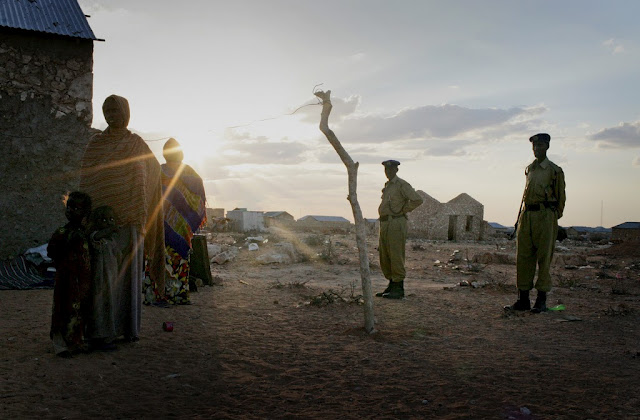-
‘The Plundered Planet’: A Discussion With Paul Collier
› Who owns the planet’s natural wealth found underwater, below ground, and in the air? How do we reconcile our use of these assets with that of future generations? Such questions are the subject of Oxford Professor Paul Collier’s latest book, The Plundered Planet: Why We Must–and How We Can–Manage Nature for Global Prosperity, which he discussed at a recent Wilson Center event.
Who owns the planet’s natural wealth found underwater, below ground, and in the air? How do we reconcile our use of these assets with that of future generations? Such questions are the subject of Oxford Professor Paul Collier’s latest book, The Plundered Planet: Why We Must–and How We Can–Manage Nature for Global Prosperity, which he discussed at a recent Wilson Center event.
The author of The Bottom Billion and Breaking the Conflict Trap, Collier called Plundered Planet “the most important book I’ve written.” Resources are a “one-shot game,” he said; if we waste them, they’re gone. The next 10-20 years are “vital” to preserving natural assets as new technologies for removing them proliferate. We’re sucking fish up like “hoovers,” he said, and a combination of technology and economic growth are rapidly pushing mineral extraction into the few remaining frontiers.
Because time is short, Collier hopes his work will bring economists and environmentalists together. He said the two groups are largely at each other “cat and dog,” yet their objectives–environmental preservation and economic development–are not fundamentally opposed. In fact, to overcome polarization and produce key policy decisions, development and conservation must become partners.
Becoming Custodians, Not Curators
Collier said resource plunder can take one of two forms: “Where the few expropriate what belongs to the many”; and “where nature is expropriated by the present generation and burned up rather than benefiting future generations.” Both forms of plunder not only impede development, but are also unjust, he said.
Unlike other assets–such as books or records, which are typically owned by their authors or artists–natural assets have no human creators. A system whereby “natural assets are owned by the people who are lucky enough to live on top of them” creates “staggering inequality,” said Collier. Instead, resources must be shared equally among all citizens of a nation, including those not yet born.
Yet sharing nature’s wealth with generations to come does not mean leaving all fish in the sea, all trees on land, or all minerals underground. “We are not curators of natural artifacts,” Collier said. “We’re custodians of natural value.”
For the one billion people living in poverty, the development of natural resources can provide a path toward development, growth, and better lives, Collier argued, when properly and justly managed.
Filling the Gaps in Governance
Why have we largely plundered, rather than invested in, our resources thus far? What can be done to change the current principles of resource management? Collier’s short answer: governance.
For the poor countries in the “bottom billion,” Collier said the “broken decision chain” must be mended. The chain has six steps:- Discovering natural assets;
- Avoiding appropriation by a few at the expense of the many;
- Ensuring local inhabitants receive generous compensation for unavoidable environmental damage;
- Consuming in a way that benefits both the present and the future;
- Investing in the absorptive capacity of government; and
- Investing in domestic development.
Igniting a Movement
“There is no substitute…for building a critical mass of informed opinion,” Collier said. While technology enables plunder, it also creates a way for people to share knowledge at tremendous speeds and with wide audiences. The challenge, he said, “is to ignite the information transformation process.” A shift from plunder to sustainable management of transnational and developing country resources is a historic opportunity to benefit the world’s poor. “If these resources are harnessed for sustained development,” he said, “they can drag themselves decisively from poverty to prosperity.” The window of opportunity, however, is closing. -
Rare Earth: A New Roadblock for Sustainable Energy?
›June 7, 2010 // By Wilson Center Staff
The 2010 National Security Strategy emphasizes that energy independence is part of a larger strategy for national security, stating, “As long as we are dependent on fossil fuels, we need to ensure the security and free flow of global energy resources.”
However, the alternatives to fossil fuels–such as wind energy, hybrid vehicles, and energy-efficient light bulbs–could also lead to dependence on international resources. They require minerals known as rare earth elements or minerals (REEs). REEs are required for producing the magnets necessary for a variety of goods, including precision-guided munitions, computer hard drives, lasers, communication and radar systems, satellites, and color televisions.
But China has a virtual lock on the production of REEs. In response, U.S. policymakers requested the GAO produce a detailed assessment of REEs in the U.S. defense supply chain as part of the 2010 National Defense Authorization Act. At the same time, the Pentagon is changing its policies regarding acquiring and stockpiling REEs.
Demand for Rare Earth Predicted to Rise
CEO Mark Smith of Molycorp Minerals, a U.S. rare earth mining operation, told HardAssetsInvestor.com:Today the largest use of these magnets is in hard disk drives… We believe that may be changing as hybrid cars become more popular and the use of wind turbines becomes more widespread. Clearly, on a volumetric basis, these two new clean energy technologies could easily overtake hard disk drives in terms of the volume of permanent rare earth magnets required.
Despite their name, REEs are not necessarily rare–known stocks and demand vary widely by element–but supplies of some key elements are short, reports Robin Bromby of The Australian.
China Corners the Rare Earth Market
The growing attention paid to REE supply stems more from the location of mining and production facilities rather than pure scarcity concerns. According to the GAO assessment, China produced 97 percent of rare earth oxides in 2009, and it has established economic protections on rare earth exports. The United States Magnet Material Association has estimated that China’s consumption of rare earth materials will outpace its supply between 2012-2015.
“What we need to be careful of is that we don’t unknowingly change our dependence on foreign oil to a new dependence on Chinese rare earths,” Molycorp’s Smith told HardAssetsInvestor.com. While new technologies may change the type of battery used in hybrids, “the one thing that cannot change in electric vehicles or hybrid vehicles is the use of permanent rare earth magnets in the motors and generators. There is simply no substitute for those magnets,” said Smith.
U.S. Seeks Secure Supplies
Given the lack of substitutes, the United States is attempting to secure access to REEs. Known deposits exist in the United States, Australia, Brazil, India, Canada, South Africa, and Greenland. However, in order for the United States to procure secure access to REEs, they must both acquire mines and processing facilities for the multi-stage production process, which today takes place almost entirely in China.
The GAO estimates it may take up to 15 years for the United States to produce a finished product. In that time, Chinese consumption is expected to have vastly increased and demand for certain REEs may be very high.
Washington is taking this threat seriously. As pointed out by CNAS’ Christine Parthemore, the 180-day turnaround time on the GAO’s rare earth assessment was considerably shorter than for other assessments, including a plan for operational use of biofuels.
The Pentagon is revamping its stockpiling practices, reducing bureaucratic barricades to changing quotas, broadening buying options, and growing the array of stockpiled resources, the Wall Street Journal reported, adding:The rising competition for raw materials has sparked fears in the U.S. military that some materials that once seemed abundant could suddenly become hard to get at any price. In 2008 the military suspended or limited sales of 13 commodities it had previously considered excess. Last year it added 14 materials to its list of resources it considers for stockpiling, including specialty steels, lithium and some rare-earth elements, taking the total to 68. More additions are expected, said Ms. Stead of the Defense National Stockpile Center.
While it seeks secure supplies of REEs, the United States, and the defense community in particular, should take heed of the long history of minerals and conflicts around the world. Global demand for certain minerals has supported combatants in conflict areas; for example, control of coltan mines in the Democratic Republic of Congo, while producing only 1 percent of global supply, played a significant role in that country’s civil war.
The switch to alternative transportation fuels could similarly produce new patterns of global resource demand that spur or support conflict–a phenomena that will be explored in an upcoming ECSP event, “Backdraft: The Conflict Potential of Climate Mitigation and Adaptation.”
On the other hand, done correctly, mineral extraction could be a way to break the “resource curse” and increase cooperation rather than conflict. In Pakistan, “development and maintenance of an extractive mineral industry could revolutionize the Waziristan economy and infrastructure in the long-term,” says Natural Security, which could provide “an incentive for local cooperation.”
Ultimately, the way that the United States seeks to slake its hunger for resources will determine whether it can stockpile its way to security.
Tara Innes is a PhD student at the University of Maryland, studying conflict-environment linkages and an intern with ECSP.
Photo Credit: Adaptation of Periodic Table, courtesy Flickr user Destinys Agent -
VIDEO: Paul Collier On Romantics and Ostriches
›June 4, 2010 // By Dan Asin“I’m trying to build common ground between environmentalists and economists. Those two groups are being cat and dog for a long time,” author and Oxford professor Paul Collier, speaking about his new book The Plundered Planet, tells ECSP.
Collier says the interests of the two groups have thus far been dominated by their “fundamentalist” wings: On one side the environmental “romantics,” who value nature over people, and on the other the economic “ostriches,” who deny that nature’s a priori existence endows it with unique characteristics.
Work toward resolving two of the world’s most pressing challenges, environmental degradation and poverty, demands collaboration and mutual recognition by both sides. “If you take that romantic view of nature,” says Collier, “we will never feed a world of 9 billion people–we will never lift the poorest people out of poverty.” At the same time, nature does not belong exclusively to those living today, and its value must be preserved for future generations. “Those rights of the future have to be respected,” he says.
“The romantics and the ostriches, between them at the moment, are winning,” says Collier. “[I]t’s very important they start to lose.” -
Improving Transportation and Referral for Maternal Health
›“Referral has been called an orphan cause,” said Patricia Bailey, public health specialist for Family Health International and Columbia University, because it is “everybody’s responsibility and therefore nobody’s responsibility.”
As part of the Maternal Health Dialogue Series the Woodrow Wilson International Center for Scholars’ Global Health Initiative convened a small technical meeting on May 19, 2010, with 25 experts from five countries to discuss their experiences and share lessons, challenges, and recommendations for improving transportation and referral for maternal health. Following the technical meeting, a public dialogue was held on May 20, 2010, to share the knowledge gaps and recommendations identified. The formal report from the technical meeting will be available in the near future.
Mobilizing District Communities in Rural Ghana
To improve maternal health care in Ghana, “we needed to shift [services] to the community level, where 70 percent of our population lives,” said Dr. John Koku Awoonor-Williams, the east regional director of Ghana Health Service. The “Community-based Health Planning and Services” (CHPS) program was created to galvanize local leadership and empower communities to engage in health outreach activities.
Through this approach, “community health officers and nurses are trained and delegated to distant village locations called CH[I]P zones, in which they are responsible for health education, treatment of minor illnesses, maternal and antenatal care, and referral to district hospitals for emergency care,” said Awoonor-Williams. Community health officers use two-way Motorola walkie-talkies to communicate with traditional birth attendants and referral centers. Pregnant women are given the phone numbers so they can call in the event of complications.
1-0-8 Emergency Number for Improving Maternal Health in India
Many parts of the developing world do not have a 911-style emergency response service. To address this gap, the GVK Emergency Management & Research Institute in India developed the toll-free 1-0-8 telephone number for all medical, police, and fire emergencies.
“We assure every citizen that wherever you are, [if] you call us we will be there,” said Subodh Satyawadi, chief operating officer of GVK. In order to reach the 433 million people covered by GVK, they have:
“Although we address all kinds of emergencies, we heavily focus on maternal health…31 percent of emergencies are pregnancy-related,” said Satyawadi, who said that GVK’s emergency response system has helped save more than 200,000 mothers. Institutional deliveries have increased in the state of Gujarat by 92 percent. “We have been able to reduce maternal mortality by 20-25 percent in different geographies,” he said.- 19,623 EMTs and 10,000 doctors and other healthcare professionals
- 2,710 ambulances
- 16,300 call-center employees
Pre-Hospital Barriers: Reducing Maternal Morbidity in Bolivia
Women in Bolivia receive free maternal care. In cities like La Paz, emergency obstetric care is often available within a short distance. However, “37 percent of our maternal deaths [occur] at our hospitals,” said Víctor Conde Altamirano, OB/GYN of CARE Bolivia.
To better understand this mortality rate, Altamirano evaluated whether pre-hospital barriers and routine antenatal care are associated with near-miss morbidity. He found that women who are older, have lower levels of education, lack antenatal care, are pregnant for the first time, or live in rural areas are at a greatest risk of illness or death
“We are trying to organize our communities and service facilities, and promote improved health management by the municipalities. If our authorities can be sensitive and invest in health; invest in fuel, drugs, and human resources; we can improve near-miss morbidity rates,” said Altamirano.
Strategies and Recommendations for Improving Transportation & Referral
The workshop participants agreed on six key topic areas for improving transportation and referral:1. Multi-sectoral collaboration
The group called for improved multi-sectoral engagement and continuous dialogue among key ministries: Health, Finance, Communication, Social Welfare, Security and Defense, Transportation, and Public Works.
2. Mobile phone technology
3. Public-private partnerships
4. Referral for newborns
5. Indicators for referral
6. Sharing evidence
Private-public partnerships, such as those demonstrated by GVK in India and the CH[I]P program in Ghana, create opportunities for collaboration. “Cell-phone technology can reduce delays in transport and treatment by identifying which facilities might be the most appropriate for referral,” said Bailey.
The final recommendation by the group calls for increased pooling and use of existing evidence to move the transportation and referral agenda forward. Updated synthesis papers on existing evidence are needed, said Bailey. “We have a lot of data that is perhaps less than perfect, but this should not be a barrier for further action,” she said. -
‘Frontlines’ Interviews John Sewell: “Promoting Development Is a Risky Business”
›May 31, 2010 // By Wilson Center Staff Q: Foreign assistance has had major achievements over the past 50 years. What are some examples?
Q: Foreign assistance has had major achievements over the past 50 years. What are some examples?
SEWELL: There have been many but off the top of my head I can think of three. First, the Green Revolution where the combined efforts of American aid and private foundations revolutionized agriculture in Asia. As a result, many more people lived a much longer time. Second, the efforts put into improving education, particularly of women and girls. The third is population growth. When I started working on development, the best predictions said that global population would rise to over 20 billion at the end of the 20th century. Now we know it will not go much above 9 billion and perhaps lower. That wouldn’t have happened without American leadership and funding.
Q: What are the major failures of foreign assistance?
SEWELL: Failures have occurred either because countries were not committed to development, or because aid agencies designed ineffective programs. But most major failures came about because aid was provided for political reasons— for Cold War purposes in Southeast Asia or the Middle East, not for economic and social development. And we should remember that promoting development is a risky business. If there were no failures, development agencies were being too cautious.
But the more important failures are at the strategic level. Assistance really is only effective when governments and leaders want to speed economic growth, improve health and education, and address poverty. When the government isn’t committed to development, a lot of aid is wasted.
That’s why the choice of countries is so important. Korea is one example. Korean leaders knew how to use foreign aid effectively to build agriculture and industry. Part of that assistance funded investments in health and education. We all know the result.
Egypt, on the other hand, also has received large amounts of American assistance since 1979. But its growth rates are low and they still have one of the highest rates of adult illiteracy in the world.
Perhaps the largest failure has been in Africa. Except for a small number of countries, Africa lags far behind other regions. The blame lies not just with African leaders but also with aid donors who have continued to provide assistance in ways that hinder development.
Q: In what ways can global poverty be reduced quickly in the next three to four years?
SEWELL: In the short term, it won’t happen. The global financial crisis makes that a certainty.
The best estimates are that up to 90 million people will fall back into poverty because they will have lost jobs and livelihoods. The most important thing the U.S. can do in the near term is to continue to lead the reform of the international financial systems that are essential to restarting global economic growth, particularly in the developing world.
Q: That’s the way to reduce poverty?
SEWELL: In the short term, yes. But the U.S. can target aid to build poor peoples’ capacities and can make a great difference. That means aid for education, especially women, and to enable poor people to improve their health. And jobs are critical.
I think the right goal is to empower people to move into the middle class.
That means helping to provide technical assistance and in making low-cost credits for both farmers and small scale entrepreneurs. They will be the generators of jobs that enable men and women to move out of poverty.
Q: Why do you say in one of your papers that economic growth alone will not eliminate poverty?
SEWELL: Because it’s true. Growth does not automatically diminish poverty; it has to be complemented by government actions to share the gains from growth by investing in better health and education. For this you also need a competent state. That’s how the East Asian countries managed to develop so successfully. On the other hand, many Latin American countries have grown at decent rates but have lousy income distribution. But now countries like Brazil are starting to change. For instance, the Brazilian government now pays mothers to keep their children in school where they can get education and health care.
Q: USAID has restrictions that inhibit advertising. How can the public and Congress be informed about the successes and importance of development assistance?
SEWELL: USAID has been very timid about educating the public and Congress. I am not even sure that the earlier successful programs of development education exist anymore. Some steps are easy.
USAID staff knows a lot about development. Why not send them out to talk to public groups around the country? USAID staff doesn’t even participate actively in the yeasty dialogue on development that goes on in the Washington policy community and they should be encouraged to do so. Other changes may require funding and perhaps legislation and the administration should work with the Congress to get them.
Informing the public is particularly important now when there are two major processes underway to modernize U.S. development programs and Congress is rewriting the development assistance legislation.
Q: Since China and Vietnam have both developed without democracy, how important is it to push for democracy and good governance? Are they really necessary?
SEWELL: We need to separate democracy and governance. Very few of the successful developing countries have started out as democracies; India is the big exception. On the other hand, all of the successful countries have had effective governments to do what governments should do: provide security and public goods like health and education, establish the rule of law, and encourage entrepreneurship.
We need to face the fact that no outsider, including the U.S., can “democratize” a country. But it can play an important role in helping to improve governance in committed poor countries. And one of the important parts of successful development is what a Harvard economist calls “conflict mediating institutions” that allow people to deal with the inevitable conflicts that arise within successful development.
Q: You have said that we need to make markets work. How can we help poor people begin to trade when Europe, Japan, and the United States either block imports or subsidize exports?
SEWELL: If you are serious about development, you have to give high priority to trade policy. Unfortunately, USAID seems to have very little voice in trade decisions.
The U.S. needs to focus its development trade policy on the poorest countries. The highest priority should be dropping the remaining subsidies for U.S. production of highly subsidized agricultural products like cotton that can be produced very competitively in very poor countries.
But many of these countries have difficulty selling goods in the U.S., not only because of subsidies, but also because they are not equipped to export. Transport costs are high as are the costs of meeting U.S. health and quality standards, and knowledge of marketing in America is scarce.
Here’s where USAID can play an important complementary role. U.S. companies are already providing technical assistance, some with USAID support. But USAID can expand its trade capacity building programs and focus them on the poorer countries.
Q: What about microcredit?
SEWELL: Microcredit is a very important innovation, especially for empowering poor people, particularly poor women. It’s part of the solution to ending poverty.
But there are other needs. In most poor countries, there are large groups of poor entrepreneurs who are not poor enough to get microcredit but who can’t get commercial banks to lend to them. These are people who produce products for sale— handbags, for instance—that employ 10 to 20 people, but they need capital and advice in order to grow. In the U.S., small businessmen used to borrow money from local banks.That’s how America grew. But similar institutions don’t exist in many poor countries.
Q: We are involved in so many different programs—20 or 30 different federal agencies do some sort of foreign assistance— why not just invest in education and health and let each country figure out what their own development plan should be?
SEWELL: A very good idea. I have long advocated that the U.S. should focus its programs on a few major development issues but I would go beyond just health and education. I add climate change and dealing with global health threats. We dodged the bullet on SARS [severe acute respiratory syndrome] and avian flu but we may not be so lucky in the future. And strengthening governance and strengthening weak states is essential.
The real need now is for some mechanism that oversees and coordinates the multiplicity of agencies that have programs and expertise on these critical issues. Let’s hope that emerges from the current administration’s reviews of development policy
John Sewell a senior scholar at the Woodrow Wilson International Center for Scholars, was interviewed by FrontLines Editorial Director Ben Barber. Originally published in USAID FrontLines, April 2010.Can Food Security Stop Terrorism?
›May 28, 2010 // By Schuyler NullUSAID’s “Feed the Future” initiative is being touted for its potential to help stabilize failing states and dampen simmering civil conflicts. Speaking at a packed symposium on food security hosted by the Chicago Council last week, USAID Administrator Rajiv Shah called food security “the foundation for peace and opportunity – and therefore a foundation for our own national security.”
USDA v. Taliban
›May 28, 2010 // By Dan AsinAgricultural development is the “top non-security priority” in Afghanistan, said U.S. Secretary of Agriculture Tom Vilsack, in a recent speech. “Unemployment is the best recruiting tool for the Taliban,” he told the Des Moines Register.
Sixty USDA experts are working with their partners in State, USAID, DOD, and other members of U.S. government to increase agricultural opportunities in rural areas of the country. Embedded in small civil-military units of 15-100 people, USDA experts have worked on projects of all scales: installing windmill water pumps, training veterinarians, refurbishing university research laboratories, stabilizing river banks and irrigation canals, and developing storage facilities.
In his keynote speech at the Feed the Future launch, Vilsack emphasized the need to build markets. In Afghanistan, USDA is focusing on improving infrastructure so farmers can receive deliveries and ship produce, and boosting credit vehicles to help farmers purchase the inputs to grow crops. Opium traders provide seeds to the farmers and pick up the crops at the farms, he said, which makes opium easier to produce than legal crops.
Alternative crops could be just as or more valuable, Vilsack told NPR:Table grapes are in some cases perhaps four and five times more valuable than poppy. Saffron, almonds, pomegranates, a number of fruits are significantly more profitable. What we have to do is we have to establish that the reward of putting those crops in the ground is greater and the risk is equal to or less than poppy production.
On the same NPR program, Vilsack’s counterpart agreed: “Agriculture growth means employment and employment means security. They’re so much related to each other. In places where the military operates, if you do not offer people the future, just by military means, security and stability will be a very far-reaching dream,” said Minister of Agriculture, Irrigation, and Livestock Mohammad Asif Rahimi.
But the Afghan government faces an immense challenge: Afghanistan’s unemployment rate is estimated at 35 percent, which ranks it in the bottom 20 countries in the world. With a population growth rate of 3.5 percent and nearly half the population already under the age of 15, the need for job creation is only set to increase.
While agricultural development and food security are essential, Rahimi acknowledged, alone they are not enough. The Afghan government needs a “whole of government approach,” he said. To win the hearts of its people the government must offer “an alternative to what the Talibans were offering to people…more livelihood and security and education and health, and also a better and more secure future.”
Both Vilsack and Rahimi avoid the common trap of equating hunger with conflict, instead emphasizing agricultural employment and economic opportunities as key to solving that intractable conflict.
But it’s not the only piece of the puzzle. I hope the Feed the Future’s “whole of government” approach in Afghanistan will emphasize not only agriculture, but also the environmental policies and health services, such as family planning, that can ensure that agricultural gains are sustainable even after the troops leave.
Sources: Central Intelligence Agency, Des Moines Register, NPR, United Nations Statistics Division, United Nations Population Division, U.S. Agency for International Development, U.S. Department of Agriculture, U.S. Department of State.
Photo Credit: Colonel Stephen Redman and John Van Horn of the USDA discuss crop plans with local residents while surveying the site of the Arkansas Agribusiness Development Team’s (ADT)demonstration farm plot near Shahr-e-Safa, Afghanistan, courtesy Flickr user isafmedia.The Contradictions That Define China
›As a China follower who has visited the country numerous times over the past 40 years, I have an enduring love affair with the “old” China, which prided itself on balancing the harmony of nature with its decision-making. It is tragically ironic that despite this impressive historical and cultural backdrop, current choices have pushed the country’s harmony with nature beyond the tipping point.
The atmosphere in Chengdu, the capital of Sichuan Province in central China, tells a cautionary tale of China’s current emphasis on economic growth at the expense of its citizens’ health. With lower annual sunshine totals than London, Chengdu’s perpetually grey, cloudy horizon graphically illustrates the massive industrial waste and coal-fired pollution that plague this booming city.
In April, global health experts convened in Chengdu at the 5th International Academic Conference on Environmental and Occupational Medicine, which was co-sponsored by the U.S. Centers for Disease Control and Prevention and Chinese CDC offices, to report on the impact of climate change on public health.
Because of its geography, the mountain-encircled basin in which Chengdu sits is the natural point of release for daily deposits of air pollutants and dust blown in from India and other countries to the west. A rapid series of satellite views presented by John Petterson, director of the Sequoia Foundation, brought gasps from conference attendees, as these accumulated industrial wastes were shown concentrating against the massive southern Tibetan mountain range, then turning grey and black as they moved east, before being deposited on Sichuan’s vulnerable (and already heavily polluted) basin.
Environmental risk factors, especially air and water pollution, are a major–and worsening–source of death and illness in China. Air quality in China’s cities is among the worst in the world, and industrial water pollution is a widespread health hazard.
And although air pollution is clearly a complex global problem, individual nation-states continue to approach this dilemma as though it lies between its borders alone.
Luckily, this conference was prefaced by a number of timely scientific articles on China in the Lancet. The predominantly Chinese authors clearly take the critical risks that we expect from the Lancet, which is a defender of accountability and transparency in global health. This issue brings shame to other publications who still consider their “place” to be protecting the conventional politico-economic emphasis on decision-making inherent to most industrialized countries.
At the conference, public health and climate experts openly voiced their frustration at the blatant privileging of economic priorities over the health of unknowing populations. China–the fastest growing economy in world history, with unprecedented growth driven by external “demand” and precipitous acceleration of domestic consumption–has become the poster-child for global ignorance. However, the West is an equal and essential partner, having moved their manufacturing to China for cheap labor, lax environmental regulations, and higher profits.
Dr. Mark Keim, senior advisor for the CDC’s National Center for Environmental Health, presented irrefutable evidence that root structure erosion from advancing saltwater has led to starvation in Polynesia, the first recorded evidence-based outcome measure of climate change’s public health effects.
At Mark’s request, I presented evidence on the worsening health impacts of rapid urbanization, specifically within urban enclaves that expand due to dense population growth before protective public health infrastructures and systems are in place (forthcoming in Prehospital and Disaster Medicine). Currently, the megacities in Asia and Africa–where sanitation is ignored and infectious disease is prevalent–now have the highest infant and under-age five mortality rates in the world.
Today, we face the largest gap in health indices between the haves and have-nots since the alarming days before the Alma-Ata Declaration. This new health data was an uncomfortable surprise to many conference attendees, most of whom were experts in the physical and environmental sciences.
We have become too “vertical” in our research over the past 50 years, and thus we fail to recognize that solutions to problems facing the global community must be trans-disciplinary and multi-sectoral, and serve multiple ministries and decision-makers.
If not undone by human decisions, global climate change and climate-warming greenhouse gases will rapidly intensify. This effort requires the best collaboration between science and the humanities, as well as the harmonious lessons of the “old” China.
Frederick M. Burkle, Jr., MD, MPH, DTM, is a senior public policy scholar at the Woodrow Wilson Center and a senior fellow of the Harvard Humanitarian Initiative at the Harvard School of Public Health.
Photo Credit: Chengdu skyline in smog, courtesy Flickr user lonely radio.
Showing posts from category development.


